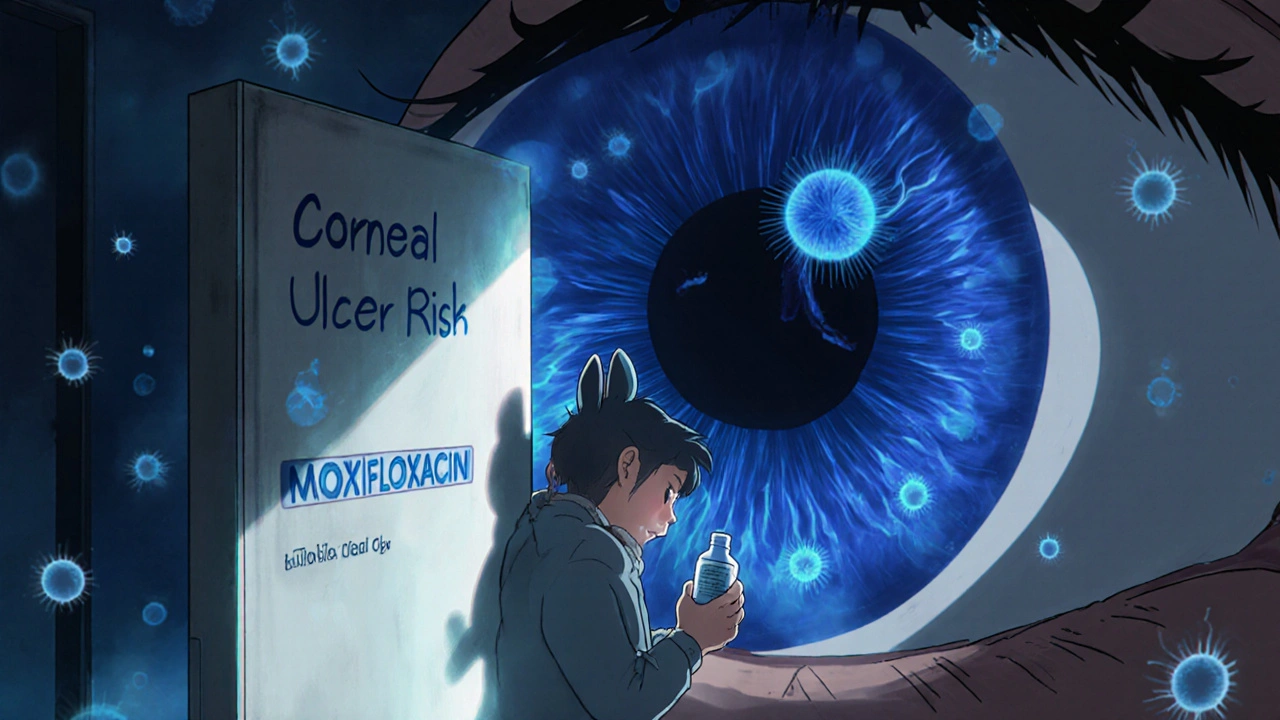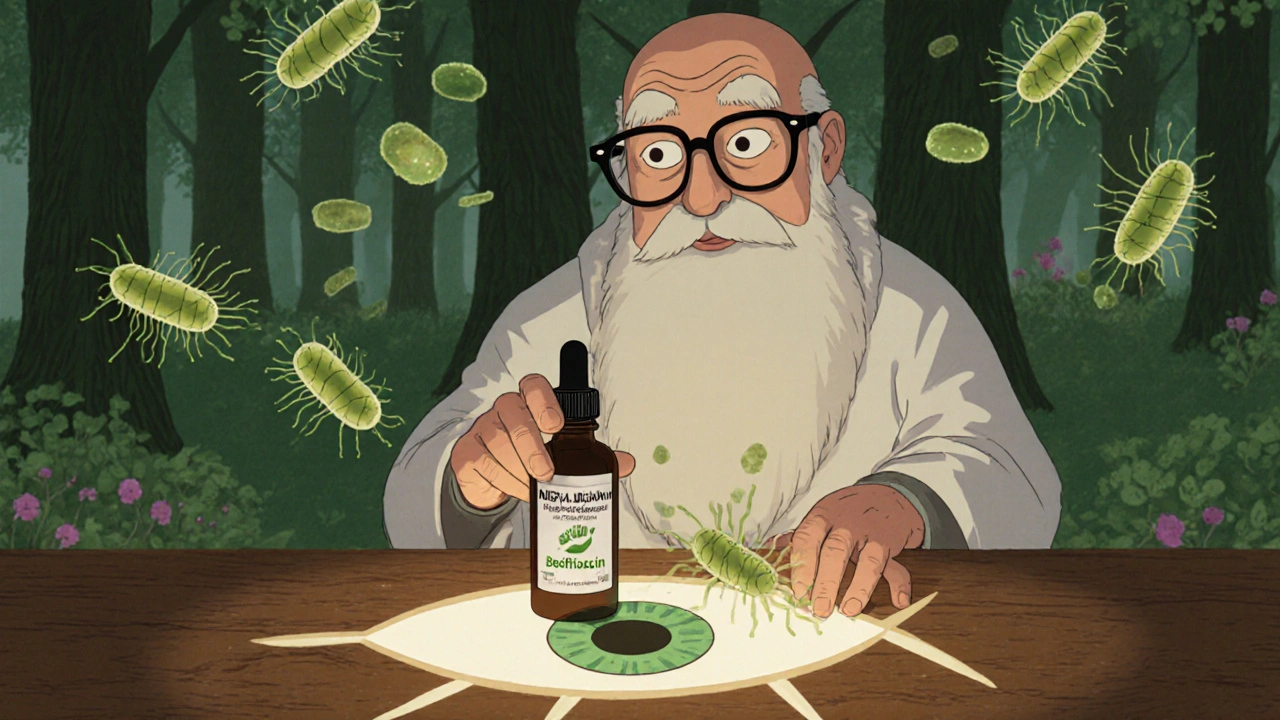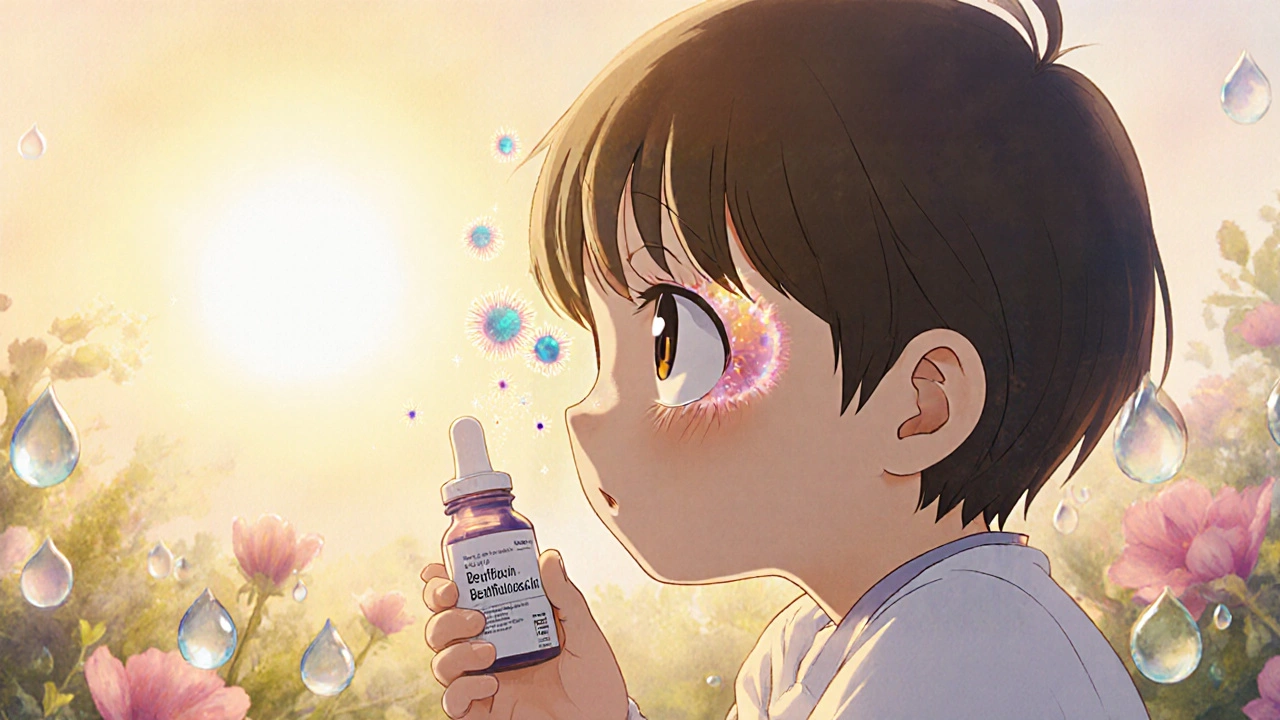When your eye turns red, feels gritty, or starts leaking pus, you don’t have time for guesswork. Your doctor hands you a bottle of eye drops-either besifloxacin or moxifloxacin. Both are powerful antibiotics, both are used for eye infections, but they’re not the same. Choosing between them isn’t about brand names or cost-it’s about what your infection needs right now.
What Makes These Two Drugs Different?
Besifloxacin and moxifloxacin both belong to the fluoroquinolone class of antibiotics. That means they kill bacteria by blocking their ability to copy DNA. But that’s where the similarity ends.
Besifloxacin was designed for one thing: eyes. It’s the only fluoroquinolone approved specifically for topical ophthalmic use in the U.S. That means it was tested and formulated to work on the surface of the eye, not to be absorbed into the bloodstream. Its chemical structure was tweaked to stay in the eye longer and hit harder on the bugs that cause conjunctivitis and corneal ulcers.
Moxifloxacin, on the other hand, was originally made for pneumonia and sinus infections. Doctors later discovered it worked well in the eye too, so they started using it off-label. It’s a broader-spectrum drug-effective against more types of bacteria-but it doesn’t cling to the eye’s surface as well. That’s why it’s often prescribed in higher concentrations (0.5%) compared to besifloxacin (0.6%).
Which One Kills More Bacteria?
A 2023 study in the Journal of Ocular Pharmacology and Therapeutics tested both drugs against 212 strains of common eye pathogens. The results were clear: besifloxacin killed 98% of Staphylococcus aureus, including resistant strains. Moxifloxacin hit 93%. For Streptococcus pneumoniae, besifloxacin was again ahead-97% vs. 91%.
Why does this matter? Because antibiotic resistance is climbing. In New Zealand, over 25% of conjunctivitis cases now involve methicillin-resistant Staphylococcus aureus (MRSA). If your infection is stubborn, besifloxacin’s tighter focus gives it an edge.
But moxifloxacin still holds its ground against Gram-negative bacteria like Pseudomonas aeruginosa. That’s the bug that can turn a scratched cornea into a vision-threatening emergency. Moxifloxacin penetrates deeper into corneal tissue, making it a better choice if there’s a chance of ulceration.
How Long Do They Last in Your Eye?
It’s not just about killing bugs-it’s about sticking around long enough to kill them all.
Besifloxacin has a unique property: it binds to the tear film and corneal surface. This means it stays active for up to 12 hours after one drop. That’s why it’s typically dosed just three times a day. Fewer drops mean better compliance. You’re less likely to forget or skip a dose.
Moxifloxacin clears from the eye faster. It needs to be applied four times a day to maintain effective levels. If you’re juggling work, kids, or a busy schedule, that extra drop can mean the difference between healing and relapse.
Side Effects: What You’ll Actually Feel
Both drugs are generally well tolerated. But here’s what patients actually report:
- Besifloxacin: Mild stinging (about 12% of users), temporary blurred vision, and rare itching. No significant increase in eye pressure.
- Moxifloxacin: Slightly more burning sensation (18%), more reports of dryness, and a small risk of corneal deposits with long-term use.
One 2024 survey of 300 patients in Wellington clinics found that 68% preferred besifloxacin because it felt less irritating. That’s not just placebo-it’s a real difference in formulation. Besifloxacin is preservative-free. Moxifloxacin often contains benzalkonium chloride, a common preservative that can damage the eye’s surface over time, especially in people with dry eyes or contact lens wearers.

When Doctors Choose One Over the Other
It’s not a one-size-fits-all decision. Here’s what actually happens in clinics:
- Besifloxacin is first-line for uncomplicated bacterial conjunctivitis. If your eye is red and sticky but your vision is fine, this is the go-to. It’s also preferred for kids and elderly patients because of its safety profile.
- Moxifloxacin is chosen when there’s a risk of corneal ulcer, after eye surgery, or if the infection doesn’t respond to first-line treatment. It’s also used in hospitals where broader coverage is needed.
Some ophthalmologists keep both on hand. They start with besifloxacin for simple cases. If there’s no improvement in 48 hours, they switch to moxifloxacin. That’s not failure-it’s smart sequencing.
Cost and Accessibility
Besifloxacin is more expensive. A 5mL bottle costs around $85 in New Zealand without subsidy. Moxifloxacin runs about $55. Insurance often covers both, but some plans require prior authorization for besifloxacin because of its price.
That doesn’t mean you should pick the cheaper one. If besifloxacin clears your infection faster and reduces the chance of recurrence, you save money in the long run-fewer doctor visits, no missed work, no risk of scarring.
What Happens If You Mix Them Up?
Don’t swap them without consulting your doctor. Using moxifloxacin for a simple pink eye might work-but it’s overkill. You’re exposing your eye to unnecessary chemicals and increasing the chance of resistance. Using besifloxacin for a deep corneal ulcer? That could delay healing.
One patient in Auckland switched from moxifloxacin to besifloxacin after her infection returned. She thought the cheaper option was fine. Two weeks later, she had a corneal infiltrate. She needed a week of oral antibiotics and daily steroid drops. That’s not just painful-it’s expensive.

Real-World Tips for Using These Drops
- Wash your hands before touching the dropper. Contamination is the #1 reason treatments fail.
- Don’t let the tip touch your eye or eyelid. Even a tiny bit of bacteria can ruin the whole bottle.
- If you wear contacts, remove them before applying drops. Wait 15 minutes before putting them back in.
- Finish the full course-even if your eye feels better after two days. Stopping early breeds resistant bugs.
- Keep the bottle refrigerated after opening. Both drugs lose potency faster at room temperature.
What If Neither Works?
Antibiotics aren’t magic. If your eye doesn’t improve in 48-72 hours, you might have:
- A viral infection (like adenovirus)-antibiotics won’t touch it.
- An allergic reaction-needs steroid drops, not antibiotics.
- A fungal infection-requires antifungal treatment.
- An underlying condition like blepharitis or dry eye syndrome.
Don’t keep doubling down on drops. Go back to your doctor. They may need to swab your eye or check for other causes.
Final Takeaway
Besifloxacin is the specialist. It’s precise, potent, and built for the eye. Use it for most common infections. Moxifloxacin is the generalist. It’s broader, deeper, and better for serious or uncertain cases.
There’s no winner in this matchup-just the right tool for the job. Your eye doesn’t care about brand names or cost. It just wants the right bug killed, fast and safely. Trust your doctor’s judgment. And if you’re unsure, ask: ‘Is this the best option for what’s actually going on in my eye?’
Can I use besifloxacin for a scratched cornea?
Besifloxacin is effective for superficial corneal abrasions with bacterial infection, but for deeper ulcers or suspected Pseudomonas exposure, moxifloxacin is preferred because it penetrates corneal tissue more deeply. Always get a professional evaluation before assuming the injury is minor.
Is besifloxacin safe for children?
Yes. Besifloxacin is approved for use in children as young as 1 year old. Its preservative-free formula and low systemic absorption make it one of the safest options for pediatric eye infections. Always follow the prescribed dosage and avoid sharing bottles.
Can I use moxifloxacin if I’m allergic to penicillin?
Yes. Fluoroquinolones like moxifloxacin and besifloxacin are chemically unrelated to penicillin. An allergy to penicillin does not increase your risk of reacting to these eye drops. However, always tell your doctor about any known drug allergies.
How long does it take for these eye drops to work?
Most patients notice improvement within 24 to 48 hours. Redness and discharge should start to clear. If there’s no change after 72 hours, the infection may be resistant, viral, or caused by something else-see your doctor again.
Do I need a prescription for these eye drops?
Yes. Both besifloxacin and moxifloxacin are prescription-only medications in New Zealand and most countries. Never use leftover drops from a previous infection-bacteria change, and the wrong treatment can make things worse.
If you’ve had recurring eye infections, consider keeping a log: what symptoms you had, which drop you used, how long it took to improve, and whether it came back. That pattern helps your doctor choose better next time.


Man, I never thought about how much thought goes into eye drop formulation. It’s wild that besifloxacin was literally engineered just for the eye-like it’s the Swiss Army knife that only does one thing, but does it better than anything else. I’ve had pink eye twice and just took whatever the doc gave me. Now I’m kinda mad I didn’t ask more questions.
Okay but let’s be real-moxifloxacin’s cheaper and it still works 90% of the time. Why are we acting like besifloxacin is some magic potion? I’m not paying $85 for a bottle when $55 does the job. If your eye doesn’t improve, see a doctor-not upgrade your drops.
So let me get this straight-you’re telling me a drug designed for pneumonia is somehow *less* effective than one made for eyes? That’s like saying a chainsaw is worse than a butter knife because the butter knife was made to spread jam. The fact that moxifloxacin works on *more* bugs is a feature, not a bug. Also, who decided that sticking around longer = better? Maybe the eye just wants the problem gone, not a long-term roommate.
Wow. Just... wow. You actually wrote a 1,000-word essay on eye drops like this is a Nobel Prize-winning breakthrough. Congrats. You’ve elevated conjunctivitis to a philosophical debate. Now go touch your face. You’ve probably contaminated your dropper already.
besifloxacin is the real MVP fr fr. moxi is just the guy who shows up late to the party and thinks he’s the main attraction. also preservative free = no more dry eyes for me. been using it since last year and my contacts dont feel like sandpaper anymore. also lol at people who think cost matters when your vision’s on the line.
This is actually super helpful! I’ve been scared to ask my doc about which one to pick because I didn’t want to sound dumb. But now I feel like I can actually have a smart conversation about it. Thanks for breaking it down so clearly-seriously, this is the kind of info that saves people from unnecessary pain.
I used moxifloxacin and it burned like hell and my eye felt like it was full of glass for two days and then it came back worse and I cried in the bathroom at work and now I’m terrified to ever use eye drops again and I think my cat is judging me
you know what i learned from this? i used to think all eye drops were the same but now i see that they’re actually really different like one is like a quiet librarian who knows exactly where the book is and the other is like a loud guy who grabs every book off the shelf hoping one will help and honestly i think the quiet one is better because my eye didn’t feel weird after using it and also i read that preservatives can hurt your eyes if you wear contacts and i wear contacts so now i’m gonna ask for besifloxacin next time even if it costs more because my eyes are worth it
Just finished my 4th day of besifloxacin. Eye’s 95% better. No stinging. No blur. Just clear vision. This isn’t hype-it’s science. And honestly? Worth every penny. If you’re on the fence, just do it. Your future self will thank you.
so you americans pay 85 dollars for eye drops?? in india we get same medicine for 150 rupees and its just as good why are you all so rich and dumb
As someone who’s had recurrent eye infections since childhood and now works with patients from diverse backgrounds, I want to say this: access matters. Not everyone can afford besifloxacin. But that doesn’t mean moxifloxacin is inferior-it’s just a different tool. What matters is that doctors listen, patients are educated, and we stop shaming people for choosing based on cost. Health equity isn’t a buzzword-it’s a necessity. And yeah, wash your hands. Always.